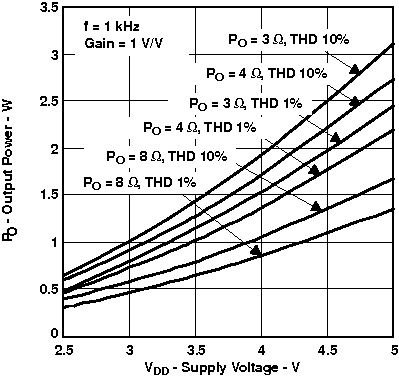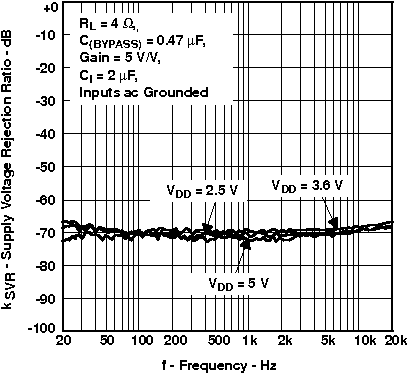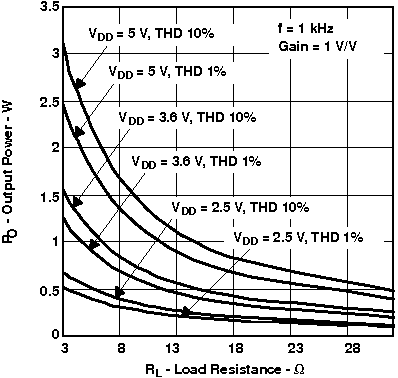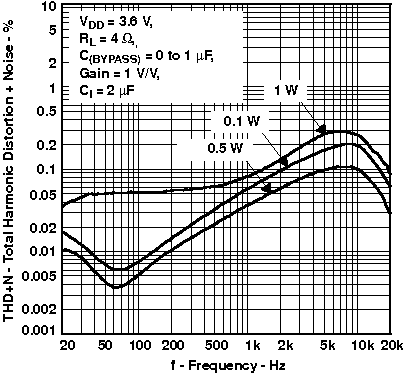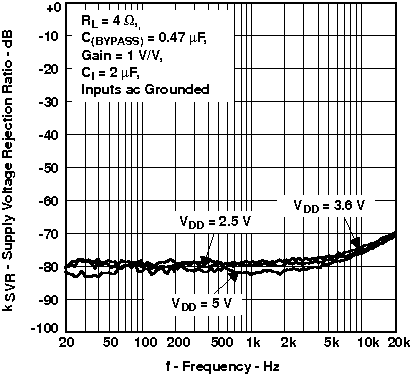SLOS367E August 2003 – November 2015 TPA6211A1
PRODUCTION DATA.
- 1 Features
- 2 Applications
- 3 Description
- 4 Revision History
- 5 Device Comparison Table
- 6 Pin Configuration and Functions
- 7 Specifications
- 8 Parameter Measurement Information
- 9 Detailed Description
-
10Application and Implementation
- 10.1 Application Information
- 10.2
Typical Application
- 10.2.1 Design Requirements
- 10.2.2 Detailed Design Procedure
- 10.2.3 Application Curves
- 10.3 System Examples
- 11Power Supply Recommendations
- 12Layout
- 13Device and Documentation Support
- 14Mechanical, Packaging, and Orderable Information
パッケージ・オプション
デバイスごとのパッケージ図は、PDF版データシートをご参照ください。
メカニカル・データ(パッケージ|ピン)
- DGN|8
- DRB|8
サーマルパッド・メカニカル・データ
発注情報
7 Specifications
7.1 Absolute Maximum Ratings
over operating free-air temperature range unless otherwise noted(1)| MIN | MAX | UNIT | |||
|---|---|---|---|---|---|
| VDD | Supply voltage | –0.3 | 6 | V | |
| VI | Input voltage | –0.3 | VDD + 0.3 | V | |
| Continuous total power dissipation | See Dissipation Ratings | ||||
| TA | Operating free-air temperature | –40 | 85 | °C | |
| TJ | Junction temperature | –40 | 150 | °C | |
| Tstg | Storage temperature | –65 | 150 | °C | |
(1) Stresses beyond those listed under Absolute Maximum Ratings may cause permanent damage to the device. These are stress ratings only, which do not imply functional operation of the device at these or any other conditions beyond those indicated under Recommended Operating Conditions. Exposure to absolute-maximum-rated conditions for extended periods may affect device reliability.
7.2 ESD Ratings
| VALUE | UNIT | |||
|---|---|---|---|---|
| V(ESD) | Electrostatic discharge | Human-body model (HBM), per ANSI/ESDA/JEDEC JS-001(1) | ±4000 | V |
| Charged-device model (CDM), per JEDEC specification JESD22-C101(2) | ±1000 | |||
(1) JEDEC document JEP155 states that 500-V HBM allows safe manufacturing with a standard ESD control process.
(2) JEDEC document JEP157 states that 250-V CDM allows safe manufacturing with a standard ESD control process.
7.3 Recommended Operation Conditions
| MIN | NOM | MAX | UNIT | |||
|---|---|---|---|---|---|---|
| VDD | Supply voltage | 2.5 | 5.5 | V | ||
| VIH | High-level input voltage | SHUTDOWN | 1.55 | V | ||
| VIL | Low-level input voltage | SHUTDOWN | 0.5 | V | ||
| TA | Operating free-air temperature | –40 | 85 | °C | ||
7.4 Thermal Information
| THERMAL METRIC(1) | TPA6211A1 | UNIT | ||
|---|---|---|---|---|
| DGN (MSOP-PowerPAD™) | DRB (SON) | |||
| 8 PINS | 8 PINS | |||
| RθJA | Junction-to-ambient thermal resistance | 62.8 | 49.2 | °C/W |
| RθJC(top) | Junction-to-case (top) thermal resistance | 61.9 | 24.8 | °C/W |
| RθJB | Junction-to-board thermal resistance | 42.1 | 58.8 | °C/W |
| ψJT | Junction-to-top characterization parameter | 3.3 | 1.7 | °C/W |
| ψJB | Junction-to-board characterization parameter | 41.9 | 25 | °C/W |
| RθJC(bot) | Junction-to-case (bottom) thermal resistance | 11 | 8.4 | °C/W |
(1) For more information about traditional and new thermal metrics, see the Semiconductor and IC Package Thermal Metrics application report, SPRA953.
7.5 Electrical Characteristics
TA = 25°C| PARAMETER | TEST CONDITIONS | MIN | TYP | MAX | UNIT | |||
|---|---|---|---|---|---|---|---|---|
| VOS | Output offset voltage (measured differentially) |
VI = 0 V differential, Gain = 1 V/V, VDD = 5.5 V | -9 | 0.3 | 9 | mV | ||
| PSRR | Power supply rejection ratio | VDD = 2.5 V to 5.5 V | –85 | –60 | dB | |||
| VIC | Common mode input range | VDD = 2.5 V to 5.5 V | 0.5 | VDD-0.8 | V | |||
| CMRR | Common mode rejection ratio | VDD = 5.5 V, | VIC = 0.5 V to 4.7 V | -63 | –40 | dB | ||
| VDD = 2.5 V, | VIC = 0.5 V to 1.7 V | -63 | –40 | |||||
| Low-output swing | RL = 4 Ω, VIN+ = VDD, VIN+ = 0 V, |
Gain = 1 V/V, VIN- = 0 V or VIN- = VDD |
VDD = 5.5 V | 0.45 | V | |||
| VDD = 3.6 V | 0.37 | |||||||
| VDD = 2.5 V | 0.26 | 0.4 | ||||||
| High-output swing | RL = 4 Ω, VIN+ = VDD, VIN- = VDD |
Gain = 1 V/V, VIN- = 0 V or VIN+ = 0 V |
VDD = 5.5 V | 4.95 | V | |||
| VDD = 3.6 V | 3.18 | |||||||
| VDD = 2.5 V | 2 | 2.13 | ||||||
| | IIH | | High-level input current, shutdown | VDD = 5.5 V, | VI = 5.8 V | 58 | 100 | μA | ||
| | IIL | | Low-level input current, shutdown | VDD = 5.5 V, | VI = –0.3 V | 3 | 100 | μA | ||
| IQ | Quiescent current | VDD = 2.5 V to 5.5 V, no load | 4 | 5 | mA | |||
| I(SD) | Supply current | V(SHUTDOWN) ≤ 0.5 V, VDD = 2.5 V to 5.5 V, RL = 4Ω |
0.01 | 1 | μA | |||
| Gain | RL = 4Ω |  |
 |
 |
V/V | |||
| Resistance from shutdown to GND | 100 | kΩ | ||||||
7.6 Operating Characteristics
TA = 25°C, Gain = 1 V/V| PARAMETER | TEST CONDITIONS | MIN | TYP | MAX | UNIT | |||
|---|---|---|---|---|---|---|---|---|
| PO | Output power | THD + N= 1%, f = 1 kHz, RL = 3 Ω | VDD = 5 V | 2.45 | W | |||
| VDD = 3.6 V | 1.22 | |||||||
| VDD = 2.5 V | 0.49 | |||||||
| THD + N= 1%, f = 1 kHz, RL = 4 Ω | VDD = 5 V | 2.22 | ||||||
| VDD = 3.6 V | 1.1 | |||||||
| VDD = 2.5 V | 0.47 | |||||||
| THD + N= 1%, f = 1 kHz, RL = 8 Ω | VDD = 5 V | 1.36 | ||||||
| VDD = 3.6 V | 0.72 | |||||||
| VDD = 2.5 V | 0.33 | |||||||
| THD+N | Total harmonic distortion plus noise | f = 1 kHz, RL = 3 Ω | PO = 2 W | VDD = 5 V | 0.045% | |||
| PO = 1 W | VDD = 3.6 V | 0.05% | ||||||
| PO = 300 mW | VDD = 2.5 V | 0.06% | ||||||
| f = 1 kHz, RL = 4 Ω | PO = 1.8 W | VDD = 5 V | 0.03% | |||||
| PO = 0.7 W | VDD = 3.6 V | 0.03% | ||||||
| PO = 300 mW | VDD = 2.5 V | 0.04% | ||||||
| f = 1 kHz, RL = 8 Ω | PO = 1 W | VDD = 5 V | 0.02% | |||||
| PO = 0.5 W | VDD = 3.6 V | 0.02% | ||||||
| PO = 200 mW | VDD = 2.5 V | 0.03% | ||||||
| kSVR | Supply ripple rejection ratio | VDD = 3.6 V, Inputs ac-grounded with Ci = 2 μF, V(RIPPLE) = 200 mVpp |
f = 217 Hz | -80 | dB | |||
| f = 20 Hz to 20 kHz | -70 | |||||||
| SNR | Signal-to-noise ratio | VDD = 5 V, PO = 2 W, RL = 4 Ω | 105 | dB | ||||
| Vn | Output voltage noise | VDD = 3.6 V, f = 20 Hz to 20 kHz, Inputs ac-grounded with Ci = 2 μF |
No weighting | 15 | μVRMS | |||
| A weighting | 12 | |||||||
| CMRR | Common mode rejection ratio | VDD = 3.6 V, VIC = 1 Vpp | f = 217 Hz | -65 | dB | |||
| ZI | Input impedance | 38 | 40 | 44 | kΩ | |||
| Start-up time from shutdown | VDD = 3.6 V, No CBYPASS | 4 | μs | |||||
| VDD = 3.6 V, CBYPASS = 0.1 μF | 27 | ms | ||||||
7.7 Dissipation Ratings
| PACKAGE | TA ≤ 25°C POWER RATING |
DERATING FACTOR(1) |
TA= 70°C POWER RATING |
TA= 85°C POWER RATING |
|---|---|---|---|---|
| DGN | 2.13 W | 17.1 mW/°C | 1.36 W | 1.11 W |
| DRB | 2.7 W | 21.8 mW/°C | 1.7 W | 1.4 W |
(1) Derating factor based on high-k board layout.
7.8 Typical Characteristics
Table 1. Table of Graphs
| FIGURE | |||
|---|---|---|---|
| PO | Output power | vs Supply voltage | Figure 1 |
| vs Load resistance | Figure 2 | ||
| PD | Power dissipation | vs Output power | Figure 3, Figure 4 |
| THD+N | Total harmonic distortion + noise | vs Output power | Figure 5, Figure 6, Figure 7 |
| vs Frequency | Figure 8, Figure 9, Figure 10, Figure 11, , Figure 12 | ||
| vs Common-mode input voltage | Figure 13 | ||
| KSVR | Supply voltage rejection ratio | vs Frequency | Figure 14, Figure 15, Figure 16, Figure 17 |
| KSVR | Supply voltage rejection ratio | vs Common-mode input voltage | Figure 18 |
| GSM Power supply rejection | vs Time | Figure 19 | |
| GSM Power supply rejection | vs Frequency | Figure 20 | |
| CMRR | Common-mode rejection ratio | vs Frequency | Figure 21 |
| vs Common-mode input voltage | Figure 22 | ||
| Closed loop gain/phase | vs Frequency | Figure 23 | |
| Open loop gain/phase | vs Frequency | Figure 24 | |
| IDD | Supply current | vs Supply voltage | Figure 25 |
| vs Shutdown voltage | Figure 26 | ||
| Start-up time | vs Bypass capacitor | Figure 27 | |
